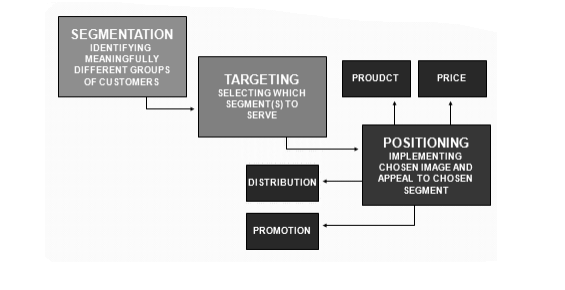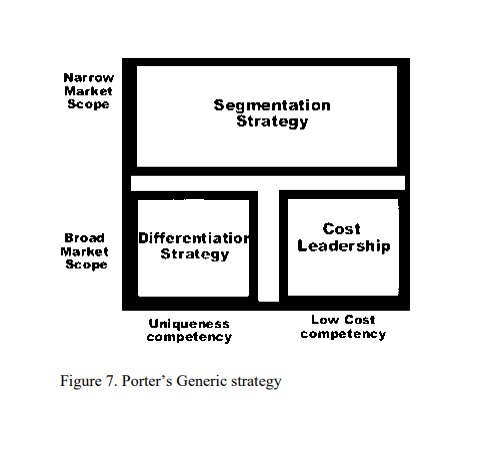Marketing strategy is a plan which determines the firm’s marketing goals; marketing strategy explains how the goals will be achieved within a stated framework. It also determines the choice of target market segment, positioning, marketing mix and allocation of resources. A clear understanding of marketing management philosophies of choice, the marketing environment, Consumer behavior and extent of the use of the marketing information systems affects the nature and quality of marketing strategy.
Marketing strategy can be undifferentiated marketing strategy, or a differentiated marketing strategy. Undifferentiated marketing strategy refers to the process of not dividing the market of consumers into groups based on one or more shared internal or external characteristics. An undifferentiated targeting strategy is used when a firm decides to communicate the benefits of its product by
sending the same promotional message to everyone. For an undifferentiated strategy to be successful, the product must be readily available and affordable and must provide the same benefits to all consumers. The differentiated marketing strategy refers to the process of dividing the market of consumers into groups based one or more shared internal or external characteristics. The differentiated marketing is a market segmentation strategy.
Market segmentation
The division of a market into different homogeneous groups of consumers is known as market segmentation. Market segmentation is an adaptive strategy. The application of market segmentation serves the purpose of developing competitive scope, which can have an effect on competitive advantage.
A viability of market segment is based on these criteria:
1. The segment is measurable
2. The segment is accessible or reachable by communication and distribution channels
3. The segment is stable or durable, not changing quickly
4. The segment is substantial in size to be profitable
5. The segment is unique or differentiable needs to serve
Market segmentation can be divided into consumer market segmentation and business market segmentation. Business Market Segmentation is when segmentation is applied to businesses and organizations on the bases of the following:
Geography: the regional variables such as regional economic growth, and customer concentration, for example, in Nairobi or in Mombasa
Customer type: for example, the size of the organization, and the industry
Buyer behavior: for example, usage patterns, and order size
Bases of consumer market segmentation
There are four primary bases to segment the consumer market:
1. Geographic segmentation
2. Demographic segmentation
3. Psychographic segmentation
4. Behavioral segmentation
1. Geographic segmentation
In geographical segmentation, market is divided into different geographical units like:
- Regions (by country, nation, state, neighborhood)
- Population density (urban, suburban, rural)
- City size (size of area, population size and growth rate)
- Climate (regions having similar climate pattern)
A firm, either serving a few or all geographic segments, needs to put attention on variability of geographic needs and wants. After segmenting consumer market on geographic bases, companies localize their marketing efforts (product, advertising, promotion and sales efforts).
2. Demographic segmentation
In demographic segmentation, market is divided into small segments based on demographic variables like:
- Age
- Gender
- Income
- Occupation
- Education
- Social class
- Generation
- Family size
- Family life cycle
- Home ownership
- Religion
- Ethnic group/race
- Nationality
Demographic factors are most important factors for segmenting the customers groups. Consumer needs, wants, usage rate these all depend upon demographic variables. So, considering demographic factors, while defining marketing strategy, is crucial.
3. Psychographic segmentation
In Psychographic Segmentation, segments are defined on the basis of social class, lifestyle and personality characteristics. Psychographic variables include:
- Interests
- Opinions
- Personality
- Self Image
- Activities
- Values
- Attitudes
A segment having demographically grouped consumers may have different psychographic characteristics.
4. Behavioral segmentation
In this segmentation market is divided into segments based on consumer knowledge, attitude, use or response to product. Behavioral variables include:
- Usage rate
- Product benefits
- Brand loyalty
- Price consciousness
- Occasions (like holidays )
- User Status (first time, regular or irregular)
Target marketing and positioning strategy
As part of adaptive strategy, after segmentation, what can follow is target marketing and positioning . Figure 6 illustrates the interrelationship

Figure 6. Relationship of segmentation, targeting and positioning strategies Segmentation, targeting and positioning strategies are differentiated strategy.
Target marketing
Target marketing is defined as the identification of the market segments that are identified as being the most likely buyers of a firm’s product.
The advantages of target marketing include:
1. Marketing opportunities and unfilled ‘gaps’ in a market may be more accurately appraised and identified. Such gaps can be real or they can be illusionary in terms of the way people want to view the product
2. Market and product appeals through manipulation of the marketing mix can be more delicately tuned to the needs of the potential customer
3. Marketing effort can be concentrated on the market segment which offer the greatest potential for the company to achieve its goals
Positioning strategy
Positioning refers to how the firm wants its consumers to see its product. And a positioning strategy results in the image the firm wants to draw in the mind of it customers, the picture it wants the customers to visualize of the firm’s offer, in relation to the market situation, and any competition that the firm may have.
There are different positioning themes:
Attribute positioning: The message highlights one or two of the attributes of the product
Benefit positioning: The message highlights one or two of the benefits to the customer
Use/application positioning: Claim the product as best for some application
User positioning: Claim the product as best for a group of users
Competitor positioning: Claim that the product is better than a competiton
Product category positioning: Claim as the best in a product category
Quality/Price positioning: Claim best value for price
Niche market strategy and Generic Marketing strategy
Niche market strategy
A niche market strategy is a strategy that focuses on addressing a need for a product that is not being addressed by mainstream providers. It is a strategy that targets a small but profitable portion of a market. The strategy targets buyers who are interested in the type of product being offered. A niche product, by its mere nature, might be not the one that has a broad-based appeal. With this in mind, a marketing niche strategy needs to seek out interested parties where they might be.
Generic marketing strategy
Within the context of market segmentation, there is another marketing strategy called Generic marketing strategy. The Generic marketing strategy aims at giving competitive advantages to the firms. The most common generic marketing strategy is the one based on the model developed by Porter. According to this model, there is segmentation strategy, differentiation strategy and cost leadership strategy that gives firms competitive advantages. Figure 7 presents the model:

